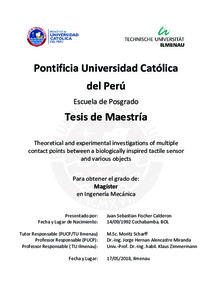| dc.contributor.advisor | Alencastre Miranda, Jorge Hernán | |
| dc.contributor.author | Fischer Calderón, Juan Sebastián | |
| dc.date.accessioned | 2021-09-15T19:02:29Z | |
| dc.date.available | 2021-09-15T19:02:29Z | |
| dc.date.created | 2018 | |
| dc.date.issued | 2021-09-15 | es_ES |
| dc.identifier.uri | http://hdl.handle.net/20.500.12404/20354 | |
| dc.description.abstract | The somatosensory system of mammals includes sensory hairs (vibrissae) for tactile perception
during near field exploration. Interacting with the environment, the tactile hair transfers
mechanical stimuli to the hair follicle (follicle-sinus complex). The follicle-sinus complex transduces
the singnals and transmits them to the central nervous system. Rats, e.g., are able to characterize
objects with regard to their surface and geometric shape. Inspired by the biological paragon, the
implementation of a vibrissa-like tactile sensor is an object of engineering research. According
to the sensory organ, the function of a technical vibrissa is based on the recording of stimuli
by the artificial hair shaft and their measurement at the support. This enables the detection
of technically relevant information. In this context, the present work focuses on the task of
object contour reconstruction. For that purpose, the support reactions are determined during
scanning of an object. Previous investigations have been restricted on scanning objects with
convex contours. This is due to the limitation of mechanical models to single-point contact
scenarios. Goal of the present work is the consideration of multiple contact points between
sensor shaft and object contour. The sensor shaft is modelled as a Euler-Bernoulli beam. The
mathematical/theoretical description of the deformation of the beam during quasi-static scanning
results in a multipoint boundary value problem with switching point. In order to simulate
scanning sweeps along two different object types, the corresponding multipoint boundary value
problems are solved by applying a shooting method incooperating a Runge Kutta Method of 4th
order. The support reactions are calculated during scanning. It shows that multi-point contacts
can be identified in the support reactions. The simulation is validated by experiments using
selected examples. | es_ES |
| dc.language.iso | eng | es_ES |
| dc.publisher | Pontificia Universidad Católica del Perú | es_ES |
| dc.rights | info:eu-repo/semantics/closedAccess | es_ES |
| dc.subject | Sensores táctiles | es_ES |
| dc.subject | Mamíferos--Vibración | es_ES |
| dc.subject | Biomecánica | es_ES |
| dc.title | Theoretical and experimental investigations of multiple contact points between a biologically inspired tactile sensor and various objects | es_ES |
| dc.type | info:eu-repo/semantics/masterThesis | es_ES |
| thesis.degree.name | Maestro en Ingeniería Mecánica | es_ES |
| thesis.degree.level | Maestría | es_ES |
| thesis.degree.grantor | Pontificia Universidad Católica del Perú. Escuela de Posgrado. | es_ES |
| thesis.degree.discipline | Ingeniería Mecánica | es_ES |
| renati.advisor.dni | 10588073 | |
| renati.advisor.orcid | https://orcid.org/0000-0001-8442-8255 | es_ES |
| renati.author.pasaporte | A2874675 | |
| renati.discipline | 713347 | es_ES |
| renati.juror | Rodríguez Hernández, Jorge Antonio | |
| renati.juror | Alencastre Miranda, Jorge Hernán | |
| renati.juror | Barriga Gamarra, Eliseo Benjamín | |
| renati.level | https://purl.org/pe-repo/renati/level#maestro | es_ES |
| renati.type | http://purl.org/pe-repo/renati/type#tesis | es_ES |
| dc.publisher.country | PE | es_ES |
| dc.subject.ocde | http://purl.org/pe-repo/ocde/ford#2.03.01 | es_ES |





